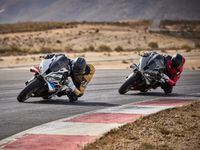I wrote an article this past May explaining why I felt the renewed rivalry between Harley-Davidson and Indian Motorcycle in American Flat Track hasn't lived up to the hype. The irony is that I am now one of only a handful of riders who has raced a Harley-Davidson XG750R and an Indian FTR750. What are the similarities and differences between those two competition-only V-twins? I could write a book detailing everything, but based on my experiences, the bikes are closer in performance than you might think.
Shortly after that story was published, I was asked to compete in my fourth consecutive X Games. I was an AFT Singles racer at the time, so I was pleasantly surprised and even humbled to receive an invitation. That being said, I wasn’t exactly prepared for the task at hand. I had my Kawasaki Ninja 750, nicknamed the “Black Hammer,” with which I had scored two AFT Twins main-event podium finishes in 2016, but I wasn’t sure if it would be competitive. I grew up in a family-owned Harley-Davidson dealership, so when Terry Vance phoned asking if I wanted to ride a Vance & Hines-built XG750R, my decision was easy.
I was a little nervous but not because I felt the pressure of being a factory rider for a weekend. I have always believed that, with the right team behind me, I could shine. I was more concerned about getting up to speed quickly enough to contend for a medal. After all, I hadn’t tested the bike and I had only ridden a twin one other time this season. But it’s just a circle, right? I would figure it out.
I rode the very first prototype XG750R for an X Games TV commercial in 2014, but the current racebike is very different from that machine so I can’t compare one with the other. In fact, the XG750R has undergone several major changes during the past 12 months. Last year, the engine was based on the Harley’s Street 750. This season, new competition-only DOHC cylinder heads provide more performance and greater reliability. In addition, the radiators have evolved to better cool the engine. Almost everything else about the engine, including the cases, remains production-based.
Racers can tell a lot about how fast they are going to go on a bike by just sitting on it. Call it the comfort factor. I felt at home right away on the XG750R. I’ve always said that I would rather be comfortable on a motorcycle with a slightly off-the-mark setup then uncomfortable on one with an ideal setup.
Before I get into the comparisons between the XG and the FTR, I want to note that I had a full team of experienced mechanics helping me set up the XG to my liking, and I basically set up the FTR by myself from the back of van with limited knowledge and resources. I raced the XG750R on a tiny short track inside US Bank Stadium in Minneapolis, Minnesota, and the FTR750 at the Williams Grove Half-Mile in Mechanicsburg, Pennsylvania. Neither track provided excellent racing conditions.
The XG750R was initially set up for factory Harley-Davidson rider Sammy Halbert, who, like me, is small, so the bike had pullback handlebars that suited my stature. Racing the XG750R on a short, bumpy track made it difficult to get a good overall feel for the bike, but I was very impressed by the way it handled. In our first practice session, when the track was wet and tacky, the bike felt really good. It turned very well through the apex of the corner and accelerated quickly. I finished between eighth and 12th during practice, so I was pleased with my performance.
During my heat race, the track became very dry and slick, the type of surface this motorcycle has visibly struggled with most of the year. It’s kind of funny because the drier the track became, the better I started to feel. The bike didn’t like a lot of throttle leaned over. To compensate for that, I avoided scrubbing too much speed on corner entry so I could stand the bike up as soon as possible through the apex and roll open the throttle all the way down the straightaway. I really liked how smoothly the throttle turned, which made it easier for me to be smooth as the track got slicker. After some early-lap chaos, I was able to pass one Indian FTR750 and catch another FTR750 and a Kawasaki battling for the final semi transfer position. I came up short, but I felt better on the motorcycle than my results showed. I had a lot of fun riding the bike and would like to see what I could do on it at a half-mile or mile.
A few days before this month’s Williams Grove Half-Mile, I was approached with an opportunity to race an Indian FTR750 in the last three rounds of the AFT series. My goal was to return to the Twins class, so the decision wasn’t difficult. I was one of the first riders to ride an FTR750 in 2016. Not much about the bike has changed since then; the engineers pretty much nailed the package right out of the gate. For the past two seasons, the bike has been all but unbeatable, winning 29 of the last 34 races and two consecutive championships.
The motorcycle I raced at Williams Grove was stock, exactly as it arrived from the factory. From the very first lap, I had a tough time getting comfortable with the chassis. As I mentioned before, I am a very small rider so the standard suspension settings weren’t ideal for my weight or the rough track. I felt really timid, so I was surprised when I finished 14th in practice and 15th and 18th in the two qualifying sessions. That is testament to the capabilities of the FTR750. I was really struggling on corner entry, but through the apex and off the corner I made up a lot of time—even though the transmission wasn’t shifting very well. Due to a weather-shortened program, I didn’t get many laps. I got an awful start in my semi that left me in last place coming off turn 2. I passed a handful of riders and got right on the rear tire of the final transfer position with two laps to go. Unfortunately, I hit a hole coming off turn 4 and almost looped the bike, which ruined any chance of reaching the main.
The FTR750 is an absolute monster. That was probably the most uncomfortable I have felt on a twin in a long time, yet I nearly made the main event at my first Twins national of the season and my first time on the motorcycle. I was making uncharacteristic mistakes each lap, but I could still use the power of the FTR750 to my advantage while chasing riders ahead of me.
After watching the main event and hearing how high other Indian riders were revving their engines, I realized our gearing had been way off the mark. Moving forward, I had the Öhlins shock rebuilt to better suit my weight. I also pulled a Yamaha YZF-R6 fork off one of my personal bikes so I expect to be more comfortable on the bike at the remaining two rounds of the schedule.
I felt a lot more comfortable on the XG750R than I did on the FTR750. The XG felt lazier power-wise than the FTR but the crazy thing about the FTR is that, even though it had exceptionally snappy throttle response, the tire didn’t want to spin. That is a hard combination to find on a dirt oval and a big reason why I think the motorcycle is so successful. With a better setup on the Indian, I believe I can be a strong contender. That said, if you think buying an Indian will instantly put you at the front of the pack, you are mistaken. Seat time and a good setup are crucial at this level no matter what brand or model of bike you are riding.
Both of these motorcycles are virtually impossible to purchase right now. Aside from buying a stock Harley-Davidson Street 750 engine and putting it in a flat-track frame, the XG750R really isn’t available to the public. And that option would be a significant downgrade from the factory machine. The Indian FTR750 was available for about $45,000, but I don’t think Indian intends to build any more of them. Most are either racing or locked up in museums.
I will be back on the Indian FTR750 this Saturday at the Minnesota Mile at Canterbury Park in Minneapolis and again the following weekend for the AFT season finale at the Meadowlands Mile in East Rutherford, New Jersey. Hopefully with a winning setup.










/cloudfront-us-east-1.images.arcpublishing.com/octane/ZC2IAVHIUJCOTFR6H45TN6OHFI.jpg)
/cloudfront-us-east-1.images.arcpublishing.com/octane/TPZBKQSCAJGKVGINOXM7VW2XJM.jpg)
/cloudfront-us-east-1.images.arcpublishing.com/octane/Y5Z6CVKY4BFHDP6WF5YOVS3LPA.jpg)
/cloudfront-us-east-1.images.arcpublishing.com/octane/AUE3NFVRRZDSBIDVUGIYIDQNUI.jpg)
/cloudfront-us-east-1.images.arcpublishing.com/octane/LYR62CH2WNBMHJJVXVATZHOUE4.jpg)
/cloudfront-us-east-1.images.arcpublishing.com/octane/RBCTRGBQYBDK7A6XPG3HKPS7ZQ.jpg)
/cloudfront-us-east-1.images.arcpublishing.com/octane/MQXQRYMZVBCWJIRYP3HEN3SHVE.jpg)
/cloudfront-us-east-1.images.arcpublishing.com/octane/TSPODNNEWRDSVJGUCNQTDG4ADI.jpg)
/cloudfront-us-east-1.images.arcpublishing.com/octane/X5TB7BDV4BA2RPSY54ZGK27RP4.jpg)
/cloudfront-us-east-1.images.arcpublishing.com/octane/REUHOJXRDBGZ5IHBYZCCBCISPA.jpg)
/cloudfront-us-east-1.images.arcpublishing.com/octane/52LGJTCKBFEHDF7S7H4CVUIMGM.jpg)
/cloudfront-us-east-1.images.arcpublishing.com/octane/YMWAIPIPSJAOXOU3QMJMGH37OM.jpg)


/cloudfront-us-east-1.images.arcpublishing.com/octane/EJ6KZRGAYBCVXNL2PJXL37UVWQ.jpg)
/cloudfront-us-east-1.images.arcpublishing.com/octane/AAN4TI76M5H5JMUVEIGASWXBDU.jpg)
/cloudfront-us-east-1.images.arcpublishing.com/octane/P3RXD2UCPFF37CMB7CHPVKXORY.jpg)
/cloudfront-us-east-1.images.arcpublishing.com/octane/VZEG2EJI2RDFZNHLRZMU56MD3Q.jpg)
/cloudfront-us-east-1.images.arcpublishing.com/octane/GVJQO5FFOFBWNGODOBRB4FBAW4.jpg)
/cloudfront-us-east-1.images.arcpublishing.com/octane/BIVAK2SFIBDJJM25E7I5VU2FJE.jpg)
/cloudfront-us-east-1.images.arcpublishing.com/octane/CH5VX52UG5CFHOVH5A6UYEFWWA.jpg)
/cloudfront-us-east-1.images.arcpublishing.com/octane/ZVGJNGZRU5C33N7KN23BBFKSC4.jpg)


/cloudfront-us-east-1.images.arcpublishing.com/octane/CZ5OM3E43ZEXJHY7LCYXCHLIKI.jpg)
/cloudfront-us-east-1.images.arcpublishing.com/octane/DF5T4K5KPZFJXFCTGPYR77PKJM.jpg)
/cloudfront-us-east-1.images.arcpublishing.com/octane/RMCT2KVQBJHBZMRTSLOVPMOILU.jpg)